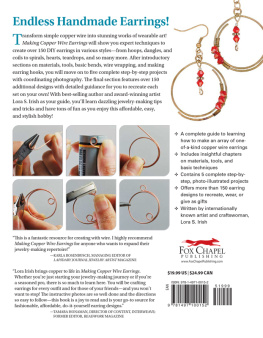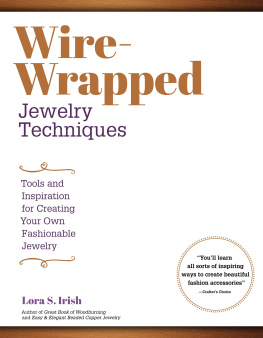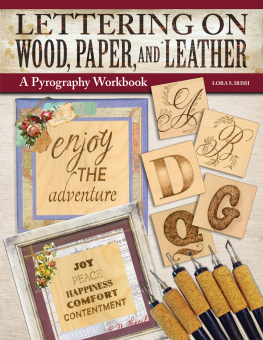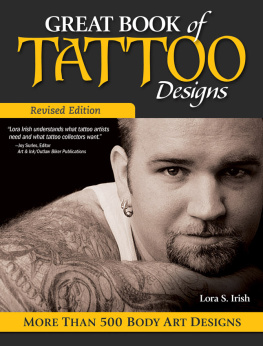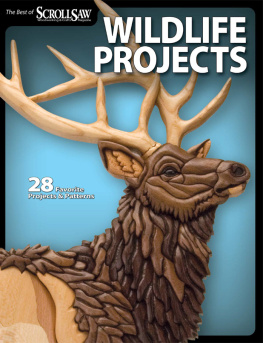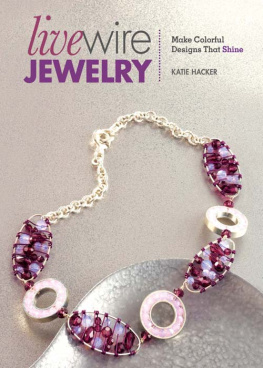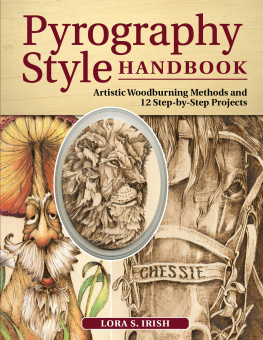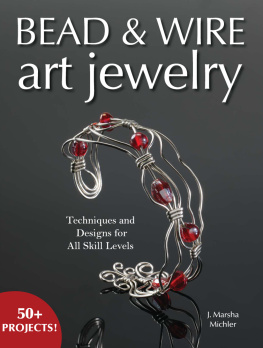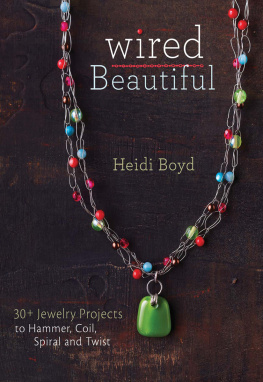Contents
Guide

Acknowledgments
I wish to extend my deepest thanks to Colleen Dorsey and Wendy Reynolds for their excellent work in the creation, development, and refinement of this book. As an author, it is a wonderful experience to work with such a well-skilled team.
2020 by Lora S. Irish and Fox Chapel Publishing Company, Inc., 903 Square Street, Mount Joy, PA 17552.
Making Copper Wire Earrings is an original work, first published in 2020 by Fox Chapel Publishing Company, Inc. All rights reserved. No part of this publication may be reproduced, stored in a retrieval system or transmitted, in any form or by any means, electronic, mechanical, photocopying, recording or otherwise, without the prior written permission of the copyright holders.
Print ISBN 978-1-4971-0015-2
eISBN 978-1-6076-5725-5
To learn more about the other great books from Fox Chapel Publishing, or to find a retailer near you, call toll-free 800-457-9112 or visit us at www.FoxChapelPublishing.com.
We are always looking for talented authors. To submit an idea, please send a brief inquiry to .
Introduction

Of all the kinds of jewelry, I think earrings are the most personally expressive that you can wear. They accent your eyes, your hair length, your neckline, and, of course, your mood. Most of all, wirework and wire-wrapped earrings add a surprise of sparkle, flash, and bling as you turn or tilt you head.
As a crafter, wire-wrapped earrings are a quick and easy outlet for the creative side of your personality. A little change in the size or shape of the beads that you use, a small difference in how you roll a tight spiral, and even the length of a chain dangle can create a totally new and unique design. A little time, a couple of dollars worth of beads and wire, and you have wonderful gifts for your family and friends.
Most of the projects presented in this book take less than half an hour to make. The earring sets that became my favorites while I was working are what I call the end of the day or bottom of my kit sets where I chose to make just one more set from what was left over from the days work. Youd be surprised at how great such pairs of earrings can turn out!
As you work through the ideas presented here, I hope that you are inspired to make even more new, unique earring sets beyond what I had the space to share with you.
So, lets get out some wire, some pliers, and some bright and sparkly beads, and lets have ourselves some fun.

Contents



CHAPTER 1
Materials and Tools
Wire, of course, is the main material needed for any wire-wrapped earring project. For the projects and samples in this book, I have used copper wire as the main link wire. A few essential tools are needed to create wirework links and to add wire-wrapped accents. A basic toolkit will include wire cutters, chain-nose pliers, round-nose pliers, nylon-jaw pliers, and some kind of file; there are also a lot of additional specialty tools that can come in handy. In addition, a variety of beads can add colorful accents to wire-wrapped earrings. With this collection of basic items, you will be able to make amazing creations. Read on for all the nitty-gritty details about wire, tools, and beads.


WIRE
Jewelry wire comes in a variety of metals and coated metals, such as gold-filled, gold-plated, sterling silver, silver-plated, brass, colored copper, copper, and color-coated aluminum.
Wire is measured by gauge; the higher the gauge, the thinner the diameter of the wire. For making links, use thick gauges from 12 (very thick) to 18 (less thick). Wrapping wires are normally worked using thinner gauges, from 20 (thin) to 26 (very thin).
Copper wire is a favorite for modern wirework jewelry and wire-wrapped jewelry. Available in round, half-round, and square, it is easy to bend and form into almost any shape. Its also great for the beginner and intermediate jewelry crafter because it is inexpensive and available in a wide range of color coatings. Throughout this book, we will be using copper wire; however, any technique taught in this book can be worked with any metal wire.
Wire comes in three hardness levels; from hardest to softest, these are full-hard, half-hard, and dead-soft. Dead-soft is what youll want to use for most of the projects in this book; you can manipulate it a lot before it becomes work-hardened (a term meaning stiffening that occurs during manipulation) and therefore difficult to further manipulate. Half-hard wire can be used for earring hooks or simpler wirework link shapes that wont require too much manipulation. Avoid full-hard wire for the projects in this book.
WIRE GAUGE
Wire thickness is measured in gauge, with smaller numbers denoting thicker wire. In this image, copper wires of four different gauges were wrapped around a 1 " (3cm)wide medicine bottle to create identically sized hoop links. From top to bottom, the gauges used are 14, 16, 18, and 20. All four hoop links are wrapped using 28-gauge wire.
While any link can be created from wire of any gauge, in general, for the projects in this book, 18- and 20-gauge wire is used as the main earring link wire, as these gauges are strong enough to hold their shape but light enough to work as earrings. 20-, 24-, and 26-gauge wire is used throughout the projects for the wire-wrapping steps, as thinner wire is more flexible when woven through the bends of the links.
Equivalents
Most jewelry wire is packaged and sold with a US gauge size and a UK millimeter size, but just in case youre in the UK and dont have the US gauge, here is a quick reference chart of US gauge and its equivalent millimeter size.
| Gauge | Millimeters |
| 12 | 2mm |
| 14 | 1.6mm |
| 16 | 1.3mm |
| 18 | 1mm |
| 20 | 0.8mm |
| 22 | 0.6mm |
| 24 | 0.5mm |
| 26 | 0.4mm |
| 28 | 0.3mm |
| 30 | 0.25mm |
| 32 | 0.2mm |


